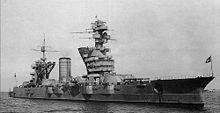Gangut (1911)
|
|
|
|---|---|

|
|
| Overview | |
| Type | Battleship |
| Shipyard |
Admiralty Shipyard, St. Petersburg |
| Order | 1908 |
| Keel laying | June 15, 1909 |
| Launch | October 7, 1911 |
| Namesake | Sea battle at Gangut |
| Commissioning | January 1915 |
| Technical specifications | |
| displacement |
New building:
after reconstruction:
|
| length |
New construction: |
| width |
26.9 m |
| Draft |
New building: 8.3 m |
| crew |
1125 men |
| drive |
|
| speed |
Max. 23.4 kn |
| Range |
4000 nm at 16 kn |
| Armament |
12 × 305 mm-L / 52 -SK |
The Gangut was the lead ship of a class of four ships of the line of the Imperial Russian Navy . It was named after the sea battle at Hanko (Russian: Gangut) in 1714.
Sister ships were the Petropavlovsk , the Sevastopol and the Poltava . The four were the first Russian dreadnoughts. Since Russian shipyards had little experience with the construction of modern capital ships, but the Duma only approved funds for construction in Russian shipyards, Italian, German (Blohm & Voss) and Scottish designs were requested, which ultimately led to a very idiosyncratic design, from the Italian Dante -Alighieri class ajar, led. The ships had an icebreaker bow, and two of the four towers were amidships in front of and behind the second chimney. It took a long time to build the ships because Russia had difficulties producing enough steel in sufficient quantities.
The Gangut was laid down on June 3, 1909 in St. Petersburg , launched on September 24, 1911, and completed in December 1914. During the First World War , the Gangut served in the Baltic Fleet, from its home port Helsingfors ( Helsinki ) - without ever being involved in major operations. The ship took part in the so-called ice march of the Baltic Fleet in 1918 .
After the end of the war in the Soviet Navy, it was renamed Oktjabrskaja Revoljuzija (October Revolution) on June 27, 1925 and was considerably modernized. After the German attack on the Soviet Union in 1941, the ship was first moved from Tallinn to Kronstadt , where it was significantly damaged in air raids on September 21, 1941. The repair took place at the Ordzhonikidze shipyard in Leningrad until October 23, 1941. The ship's heavy artillery was then used to defend the besieged city.
On April 4 and 5, 1942, parts of Kampfgeschwader 1 and 4 , Sturzkampfgeschwader 1 and 2 and Jagdgeschwader 54 attacked the Oktyabrskaya Revoljuzija in the Leningrad port. She was damaged by four bomb hits.
On July 22, 1944, the ship was honored with the Red Banner Order and has since been called the Red Banner Battleship October Revolution .
From 1954 to 1956 the Oktjabrskaja Revoljuzija served as a training ship before it was decommissioned and finally scrapped in 1959. Anchors and anti-aircraft guns have since stood as monuments in the city park of Kronstadt.
A tube of the type 305mm-L / 52 M 1907 was used in the reconstruction of the Maxim Gorki I coastal battery from 1954 .
literature
- Siegfried Breyer: Battleships and battle cruisers 1905-1970 , JF Lehmanns Verlag, Munich 1970, ISBN 3-88199-474-2 .
Web links
Individual evidence
- ↑ http://www.wlb-stuttgart.de/seekrieg/41-09.htm
- ↑ Jürgen Rohwer , Gerhard Hümmelchen : Chronik des Maritime War 1939–1945, April 1942 , accessed on March 17, 2016.
